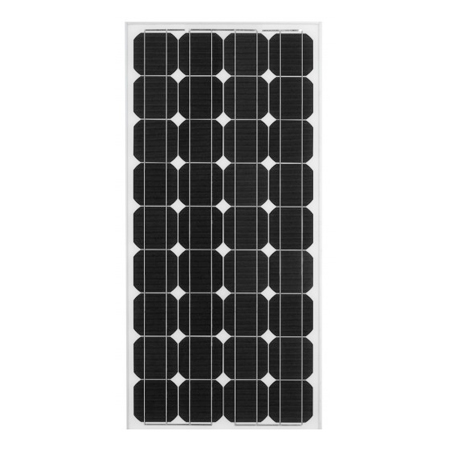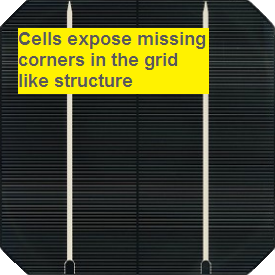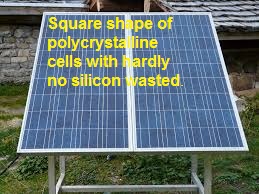- Solar Panels
- Solar Panels Cost Per Watt
- Types of Panels
Three types of solar panels to use
The types of solar panels used are Polycrystalline, Monocrystalline and Amorphous(Thin Film).
Each type of solar panels has different advantages and disadvantages. It is good to know them to make an informed decision before investing.
 MONO CRYSTALLINE PANEL
MONO CRYSTALLINE PANELMonocrystalline cells
Monocrystalline cells are also called single crystalline cells. They manufacture it from a very pure type of silicon.
Pure silicon is the most efficient when converting sunlight into electricity. Monocrystalline cells are the most efficient of all types of solar cells.
They manufacture the cells by growing a single crystal. These crystals are usually oval shaped. They cut the monocrystalline cells into patterns. It gives them a recognizable appearance.
These recognizable cells exposed missing corners in the grid-like structure.

The slices have a smooth texture and it is possible to see the thickness of the slice.
Monocrystalline solar cells expose missing corners of the grid. The polycrystalline solar cells look rectangular with no rounded edges. It is thus easy to recognize the difference between these cells.
Advantages of monocrystalline types of solar panels;
Monocrystalline panels are the most efficient of the types of solar panels. Efficiency is on average between 15 and 20%.
Monocrystalline cells are the most space efficient. You need fewer cells per unit of electrical output.
These cells last very long and most manufacturers offer guarantees of up to 25 years.
These solar panels are good performers. Even when light is low. This helps so much when you have a roof with limited space. Also if it has areas with shade.
Disadvantages;
- Monocrystalline solar panels are high in price.
- Due to the manufacturing process a large amount of the original silicon, end up being wasted.
Polycrystalline solar cells:

When manufacturing polycrystalline solar cells they melt the silicon. It is then poured into a square mold. You get a square shape of the polycrystalline cell with hardly any silicon wasted.
Polycrystalline types of solar panels are thus much cheaper than monocrystalline solar panels.
Due to this manufacturing process, the material has a lower purity. It is less efficient than the Monocrystalline panels.
Advantages of polycrystalline types of solar panels
- The process used to manufacture Polycrystalline silicon is quite simple and cheap.
- About no waste of silicon takes place in the manufacturing process.
Disadvantages of polycrystalline solar panels;
- Due to lower silicon purity, these panels are less efficient than monocrystalline cells.
- You need more surface to generate the same amount of power than the monocrystalline cell.
The thin film type of solar panel
Thin-Film Solar Cells (TFSC)are also known as amorphous solar cells. To manufacture it they deposit a layer or layers of noncrystalline silicon onto a substrate.
Of the three types of solar cells, these thin-film cells (TFPV) are the cheapest to produce. They are also the least efficient.
Currently, they base thin film solar panels on cadmium telluride, amorphous silicon, and copper indium gallium selenide.
Advantages of the thin film solar panels
- Mass production is easy and simple, making these cells cheaper to produce.
- These cells perform well under shading conditions as well as high temperatures.
- The cells are flexible. It is possible to use it for many applications and in many formats.
- You need no intercell connections.
Disadvantages of thin film cells
- You need too much space making them less viable for the average household.
- During the first couple of months of use, the power output of these cells tends to reduce. After this period the output stabilizes. The quoted output is the output after this period of stabilization.
A worthy fact
Need solar with fewer power requirements, but lightweight and portability? Then the thin film is the option to select among the different types of solar panels.
To conclude:
There is a tradeoff between cost, efficiency, application, and space.
It is imperative to study the different solar panels. Only then make your final investment.
New! Comments
Have your say about what you just read! Leave me a comment in the box below.